Berkeley, California, Hgh State Clinic, Hgh Injections, Hrt Doctors
Berkeley, California Blood Testing Facilities
 Represents a LabCorp blood testing facility
Represents a LabCorp blood testing facility Represents a Quest Diagnostics blood testing facility
Represents a Quest Diagnostics blood testing facility

Nearby Labcorp Blood Testing facilities:
- Labcorp Center Distance: 0 m, 2850 Telegraph Ave Ste 212, Berkeley, Alameda County, CA, 94705
- Labcorp Center Distance: 1 m, 3000 Colby St Ste 100, Berkeley, Alameda County, CA, 94705
- Labcorp Center Distance: 3 m, 3300 Webster St Suite 107, Oakland, Alameda County, CA, 94609
- Labcorp Center Distance: 4 m, 140 Brookwood Rd. Suite 100, Orinda, Contra Costa County, CA, 94563
- Labcorp Center Distance: 6 m, 2089 Vale Rd Ste 14, San Pablo, Contra Costa County, CA, 94806
- Labcorp Center Distance: 8 m, 728 Pacific Ave. Suite 401, San Francisco, San Francisco County, CA, 94133
- Labcorp Center Distance: 9 m, 2000 Van Ness Ave Ste 215, San Francisco, San Francisco County, CA, 94109
- Labcorp Center Distance: 10 m, 2300 Sutter St Ste 102, San Francisco, San Francisco County, CA, 94115
- Labcorp Center Distance: 11 m, 148 Noe Street, San Francisco, San Francisco County, CA, 94114
- Labcorp Center Distance: 12 m, 1601 Ygnacio Valley Road, Walnut Creek, Contra Costa County, CA, 94598
- Labcorp Center Distance: 13 m, 500 Lennon Lane, Walnut Creek, Contra Costa County, CA, 94598
- Labcorp Center Distance: 14 m, 150 Glen Cove Marina Rd. 105, Vallejo, Solano County, CA, 94591
- Labcorp Center Distance: 15 m, 1321 S. Elisio Drive, Greenbrae, Marin County, CA, 94904
- Labcorp Center Distance: 17 m, 2305 Camino Ramon Ste 110, San Ramon, Contra Costa County, CA, 94583
- Labcorp Center Distance: 19 m, 4165 Blackhawk Plz Circle 165, Danville, Contra Costa County, CA, 94506
- Labcorp Center Distance: 23 m, 5860 Owens Dr. Suite 120, Pleasanton, Alameda County, CA, 94588
- Labcorp Center Distance: 24 m, 2220 Gladstone Dr. Suite 7, Pittsburg, Contra Costa County, CA, 94565
- Labcorp Center Distance: 25 m, 4125 Mohr Ave. Suite Am, Pleasanton, Alameda County, CA, 94566
- Labcorp Center Distance: 26 m, 1048 El Camino Real Suite B, Redwood City, San Mateo County, CA, 94063
- Labcorp Center Distance: 29 m, 853 Middlefield Rd Ste 6, Palo Alto, Santa Clara County, CA, 94301
- Labcorp Center Distance: 31 m, 3448 Villa Lane Suite 103, Napa, Napa County, CA, 94558
- Labcorp Center Distance: 32 m, 153 Lynch Creek Way, Petaluma, Sonoma County, CA, 94954
- Labcorp Center Distance: 35 m, 2204 Grant Rd. Suite 104, Mountain View, Santa Clara County, CA, 94040
- Labcorp Center Distance: 36 m, 901 W. El Camino Real, Sunnyvale, Santa Clara County, CA, 94087
- Labcorp Center Distance: 39 m, 1370 Medical Center Dr Ste B, Rohnert Park, Sonoma County, CA, 94928
- Labcorp Center Distance: 41 m, 316 Rosewood Ave. 2Nd Floor, San Jose, Santa Clara County, CA, 95117
- Labcorp Center Distance: 43 m, 50 E. Hamilton Ave. Suite 80, Campbell, Santa Clara County, CA, 95008
- Labcorp Center Distance: 45 m, 1111 Sonoma Ave Ste 121, Santa Rosa, Sonoma County, CA, 95405
- Labcorp Center Distance: 46 m, 2060 Aborn Rd Ste 200, San Jose, Santa Clara County, CA, 95121
- Labcorp Center Distance: 48 m, 3540 Mendocino Ave Ste 400, Santa Rosa, Sonoma County, CA, 95403
- Labcorp Center Distance: 49 m, 393 Blossom Hill Rd Ste 350, San Jose, Santa Clara County, CA, 95123
- Labcorp Center Distance: 50 m, 6489 Camden Ave Ste 107, San Jose, Santa Clara County, CA, 95120
- Labcorp Center Distance: 53 m, 1617 N. California Street, Stockton, San Joaquin County, CA, 95204
- Labcorp Center Distance: 54 m, 8465 Old Redwood Hwy Ste 400, Windsor, Sonoma County, CA, 95492
- Labcorp Center Distance: 62 m, 1505 Soquel Dr Ste 3, Santa Cruz, Santa Cruz County, CA, 95065
- Labcorp Center Distance: 66 m, 500 University Ave 2Nd Fl, Sacramento, Sacramento County, CA, 95825
- Labcorp Center Distance: 67 m, 2 Scripps Dr. Suite 303, Sacramento, Sacramento County, CA, 95825
- Labcorp Center Distance: 69 m, 272 Green Valley Road, Freedom, Santa Cruz County, CA, 95019
- Labcorp Center Distance: 70 m, 1541 Florida Ave. Suite 102, Modesto, Stanislaus County, CA, 95350
- Labcorp Center Distance: 71 m, 1524 Mchenry Ave. Suite 160, Modesto, Stanislaus County, CA, 95350
- Labcorp Center Distance: 75 m, 6620 Coyle Ave Ste 109, Carmichael, Sacramento County, CA, 95608
- Labcorp Center Distance: 81 m, 1008 Riley St Ste 4, Folsom, Sacramento County, CA, 95630
- Labcorp Center Distance: 82 m, 1801 Colorado Ave. Suite 200, Turlock, Stanislaus County, CA, 95382
- Labcorp Center Distance: 83 m, 6815 Five Star Blvd Suite 105, Rocklin, Placer County, CA, 95677
- Labcorp Center Distance: 87 m, 89 Lincoln Blvd., Lincoln, Placer County, CA, 95648
- Labcorp Center Distance: 88 m, 1326 Natividad Rd. Suite A, Salinas, Monterey County, CA, 93906
- Labcorp Center Distance: 89 m, 559 E. Alisal St. Ste 104, Salinas, Monterey County, CA, 93905
- Labcorp Center Distance: 90 m, 1173 Fremont Blvd Ste B, Seaside, Monterey County, CA, 93955
- Labcorp Center Distance: 95 m, 222 I Street, Los Banos, Merced County, CA, 93635
- Labcorp Center Distance: 97 m, 11930 Heritage Oak Pl Ste 7, Auburn, Placer County, CA, 95603
Nearby Quest Blood Testing facilities:
- Quest Center Distance: 3 m, 3300 Webster St, Oakland, Alameda County, CA, 94609-3106
- Quest Center Distance: 7 m, 2111 Whitehall Place, Alameda, Alameda County, CA, 94501-6160
- Quest Center Distance: 8 m, 7200 Bancroft Ave, Oakland, Alameda County, CA, 94605-2468
- Quest Center Distance: 10 m, 2201 Post St, San Francisco, San Francisco County, CA, 94115-3427
- Quest Center Distance: 11 m, 2198 15Th St, San Francisco, San Francisco County, CA, 94114-1213
- Quest Center Distance: 12 m, 108 La Casa Via, Walnut Creek, Contra Costa County, CA, 94598-3013
- Quest Center Distance: 15 m, 2042 Columbus Pkwy, Benicia, Solano County, CA, 94510-5400
- Quest Center Distance: 17 m, 901 Campus Dr, Daly City, San Mateo County, CA, 94015-4930
- Quest Center Distance: 19 m, 120 S El Camino Real, Millbrae, San Mateo County, CA, 94030-3133
- Quest Center Distance: 20 m, 1241 East Hillsdale Blvd, Foster City, San Mateo County, CA, 94404-0000
- Quest Center Distance: 22 m, 5720 Stoneridge Mall Road, Pleasanton, Alameda County, CA, 94588-2851
- Quest Center Distance: 25 m, 1100 Laurel Street, San Carlos, San Mateo County, CA, 94070-5000
- Quest Center Distance: 26 m, 556 Mowry Avenue, Fremont, Alameda County, CA, 94536-4186
- Quest Center Distance: 29 m, 1411 Oliver Road, Fairfield, Solano County, CA, 94534-3424
- Quest Center Distance: 31 m, 3260 Beard Road, Napa, Napa County, CA, 94558-3406
- Quest Center Distance: 33 m, 1550 Professional Drive, Petaluma, Sonoma County, CA, 94954-6655
- Quest Center Distance: 36 m, 770 Mason St, Vacaville, Solano County, CA, 95688-4648
- Quest Center Distance: 37 m, 877 W Fremont Avenue, Sunnyvale, Santa Clara County, CA, 94087-2332
- Quest Center Distance: 41 m, 123 Disalvo Ave, San Jose, Santa Clara County, CA, 95128-1717
- Quest Center Distance: 42 m, 2618 Alum Rock Ave, San Jose, Santa Clara County, CA, 95116-2621
- Quest Center Distance: 43 m, 840 Willow St, San Jose, Santa Clara County, CA, 95125-2384
- Quest Center Distance: 45 m, 990 Sonoma Ave, Santa Rosa, Sonoma County, CA, 95404-4813
- Quest Center Distance: 46 m, 2581 Samaritan Drive, San Jose, Santa Clara County, CA, 95124-4112
- Quest Center Distance: 51 m, 2291 W March Ln, Stockton, San Joaquin County, CA, 95207-6664
- Quest Center Distance: 52 m, 1708 W Hammer Ln, Stockton, San Joaquin County, CA, 95209-2922
- Quest Center Distance: 53 m, 2800 N California St, Stockton, San Joaquin County, CA, 95204-3759
- Quest Center Distance: 54 m, 510 E. Magnolia Street, Stockton, San Joaquin County, CA, 95202-1850
- Quest Center Distance: 56 m, 801 S Ham Ln, Lodi, San Joaquin County, CA, 95242-7502
- Quest Center Distance: 59 m, 7248 South Land Park Drive, Sacramento, Sacramento County, CA, 95831-3661
- Quest Center Distance: 61 m, 1837 E Gibson Rd, Woodland, Yolo County, CA, 95776-5168
- Quest Center Distance: 62 m, 1595 Soquel Drive, Santa Cruz, Santa Cruz County, CA, 95065-1720
- Quest Center Distance: 67 m, 1045 Sperry Ave, Patterson, Stanislaus County, CA, 95363-9286
- Quest Center Distance: 69 m, 202 Green Valley Rd, Freedom, Santa Cruz County, CA, 95019-3135
- Quest Center Distance: 70 m, 7880 Wren Avenue, Gilroy, Santa Clara County, CA, 95020-7801
- Quest Center Distance: 71 m, 1524 Mchenry Ave, Modesto, Stanislaus County, CA, 95350-4566
- Quest Center Distance: 73 m, 7423 Fair Oaks Blvd, Carmichael, Sacramento County, CA, 95608-1797
- Quest Center Distance: 74 m, 2531 E Whitmore Ave, Ceres, Stanislaus County, CA, 95307-2646
- Quest Center Distance: 82 m, 777 E Hawkeye Ave, Turlock, Stanislaus County, CA, 95380-7507
- Quest Center Distance: 87 m, 631 E Alvin Dr, Salinas, Monterey County, CA, 93906-3056
- Quest Center Distance: 88 m, 223 Clinton Rd, Jackson, Amador County, CA, 95642-2603
- Quest Center Distance: 90 m, 212 San Jose St, Salinas, Monterey County, CA, 93901-3928
- Quest Center Distance: 93 m, 1025 Bridge St, Colusa, Colusa County, CA, 95932-2870
- Quest Center Distance: 95 m, 730 W I St, Los Banos, Merced County, CA, 93635-3421
- Quest Center Distance: 97 m, 3133 Professional Drive, Auburn, Placer County, CA, 95603-2463
California Hormone Replacement Therapy Services
Hormone Imbalance is a significant medical issue that many people don't consider as thoughtfully as they should. Do you feel that your body and mind are slowing down as you grow older, and do you want to do something about it?
The Conscious Evolution Institute can quickly and discreetly provide you with Physician-Monitored Hormone Replacement Therapy Solutions. We offer a number of plans and programs which have been proven to help improve the lives and wellness of millions across the United States and the World.
Testosterone Therapy in California
As we grow older, our hormone levels start to decline naturally as a result of age. Starting around the age of thirty, men can start to suffer from a decline in physical and sexual health resulting directly from Low-T. If you are experiencing a lack of sex drive or symptoms of Erectile Dysfunction, this could be the tip of the iceberg of a number of different medical problems which can have a significantly negative impact on your health and longevity.
Testosterone Deficiency can even impact female health! Especially in the areas of sexual and cardiovascular health.
HGH Replacement in California
Like Testosterone, Growth Hormone Levels also start to decline with age, to the great detriment of our health. HGH sustains the cellular metabolism of the body, feeding us energy and allowing our bodies to rebuild and rehabilitate. As HGH Levels drop, our body goes into physiological decline because it simply can't keep up with the demands of day-to-day life.
Bio-Identical Growth Hormone Injections can restore healthy adult HGH concentrations, giving the body the raw resources needed to amplify health and wellness and preserve the human body from the effects of premature aging.
Sermorelin Injections in California
Sermorelin is an alternative to Human Growth Hormone, which fulfills the same goal of mitigating the effects of Growth Hormone Deficiency. Rather than replace HGH directly, Sermorelin Acetate stimulates the body to produce more of this precious hormone, while the body still has the ability to regulate HGH Release to make sure that the body gets the optimal level of Growth Hormone.
California HCG Diet
For men and women that are looking for a way to effectively and quickly lose weight, the Conscious Evolution Institute offers HCG Injection Therapy, which, when combined with an effective and specifically-designed diet, encourages the body to rapidly burn fat while sustaining energy and limiting the sensation of hunger, making dieting much more manageable.
Major Metropolitan Areas of California
Los Angeles
Los Angeles California, also known as Tinseltown, the City of Angels, or simply L.A., is the largest metropolitan area in the state of California. The city is known for having a near-insurpassable level of glitz and glamor, and the city is probably most widely known around the world for Hollywood, the center of the global film world, where actors and directors come together to produce films with the largest budgets the world has ever seen.
The L.A. Metro is home to a number of different professional sports teams, such as the L.A. Lakers, the L.A. Clippers, and the Los Angeles Angels of Anaheim. Los Angeles is also home to the Dodgers, who moved to California from Brooklyn, New York in 1957.
San Francisco
San Francisco is widely considered one of the most unique cities in the United States, and is the second largest city in the state of California. In terms of raw diversity, there is probably no place in the United States more diverse than San Francisco, except for Queens New York. The culture of San Francisco is highly politically active and people aren't afraid to voice their concerns under any circumstances.
The city is also home to a number of pro sports teams including the San Francisco 49ers and the Giants. The Oakland Raiders, Golden State Warriors, and Oakland As play just across the San Francisco Bay. The most famous place in San Francisco is, by far, the Golden Gate Bridge, which connects San Francisco to the Golden Gate Recreational Area to the north of the city.
San Diego
San Diego is the third largest metro in the state of California, and is the furthest south of all of the major cities in the state, immediately bordering Mexico to the south. Immediately south of San Diego is Tijuana, Mexico, and beyond that is Baja California.
San Diego's economy is driven heavily by its United States Military Presence and its busy deep-water harbor. San Diego is actually the only city on the west coast which has a shipyard which builds military ships and submarines. San Diego is home to two professional sports teams, the San Diego Padres and the Chargers.
Riverside
Riverside is the largest inland metro area in California, and the fourth largest in the state. Although Riverside itself is relatively small in comparison to the other, larger cities of the state, Riverside is the key city in a highly populated region known as the Inland Empire. Other major cities include San Bernadino and Ontario, California.
Unlike most major metros in the state and the country, the Inland Empire represents a large number of cities that grew close and simultaneously, and Riverside also belongs to a census area known as the Greater Los Angeles Area, one of the largest in the country with more than 7 million people.
Sacramento
Sacramento is the fifth largest metro area in the state of California and is located inland about 85 miles northeast of San Francisco. The city is also the capital of California. Like San Francisco, Sacramento is hailed as a highly diverse city, and is frequently recognized as one of the most well-integrated cities in the United States.
Sacramento is home to a single professional sports team, the Sacramento Kings. The city also has a highly active rock culture, contributing artists such as Cake and the Deftones to the national scene. The city also has a large theatrical scene, including the Sacramento Ballet, the B-Street Theater, and the Sacramento Shakespeare Festival.
All About Berkeley, California Geographic Area
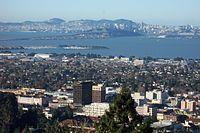
Berkeley ( /ËnbÉurkliËa/ BURK-lee) is a city on the east shore of the San Francisco Bay in Northern California, United States. Its neighbors to the south are the cities of Oakland and Emeryville. To the north is the city of Albany and the unincorporated community of Kensington. The eastern city limits coincide with the county line (bordering Contra Costa County), which generally follows the ridge line of the Berkeley Hills. Berkeley is located in northern Alameda County. The population was 112,580 at the 2010 census. The city is named after Bishop George Berkeley.
/ËnbÉurkliËa/ BURK-lee) is a city on the east shore of the San Francisco Bay in Northern California, United States. Its neighbors to the south are the cities of Oakland and Emeryville. To the north is the city of Albany and the unincorporated community of Kensington. The eastern city limits coincide with the county line (bordering Contra Costa County), which generally follows the ridge line of the Berkeley Hills. Berkeley is located in northern Alameda County. The population was 112,580 at the 2010 census. The city is named after Bishop George Berkeley.
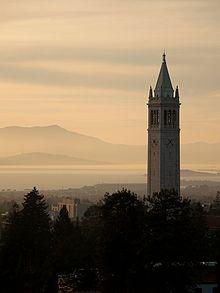
Berkeley is the site of the University of California, Berkeley, the oldest of the University of California system, and the Lawrence Berkeley National Laboratory. It is also home to the Graduate Theological Union. The city is noted as one of the most politically liberal in the nation, with one study placing it as the third most liberal city in the United States.
The site of today's City of Berkeley was the territory of the Chochenyo/Huchiun band of the Ohlone people when the first Europeans arrived. Evidence of their existence in the area include pits in rock formations, which they used to grind acorns, and a shellmound, now mostly leveled and covered up, along the shoreline of San Francisco Bay at the mouth of Strawberry Creek. Other artifacts were discovered in the 1950s in the downtown area during remodeling of a commercial building, near the upper course of the creek.
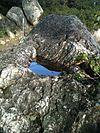
The first people of European descent (most of whom were born in America, and many of whom were of mixed ancestry) arrived with the De Anza Expedition in 1776. Today, this is noted by signage on Interstate 80, which runs along the San Francisco Bay shoreline of Berkeley. The De Anza Expedition led to establishment of the Spanish Presidio of San Francisco at the entrance to San Francisco Bay (the Golden Gate), which is due west of Berkeley. LuRs Peralta was among the soldiers at the Presidio. For his services to the King of Spain, he was granted a vast stretch of land on the east shore of San Francisco Bay (the contra costa, "opposite shore") for a ranch, including that portion that now comprises the City of Berkeley.
LuRs Peralta named his holding "Rancho San Antonio." The primary activity of the ranch was raising cattle for meat and hides, but hunting and farming were also pursued. Eventually, Peralta gave portions of the ranch to each of his four sons. What is now Berkeley lies mostly in the portion that went to Peralta's son Domingo, with a little in the portion that went to another son, Vicente. No artifact survives of the ranches of Domingo or Vicente, although their names have been preserved in the naming of Berkeley streets (Vicente, Domingo, and Peralta). However, legal title to all land in the City of Berkeley remains based on the original Peralta land grant.
The Peraltas' Rancho San Antonio continued after Alta California passed from Spanish to Mexican sovereignty after the Mexican War of Independence. However, the advent of U.S. sovereignty after the Mexican aeAmerican War, and especially, the Gold Rush, saw the Peralta's lands quickly encroached on by squatters and diminished by dubious legal proceedings. The lands of the brothers Domingo and Vicente were quickly reduced to reservations close to their respective ranch homes. The rest of the land was surveyed and parceled out to various American claimants (See Kellersberger's Map).

Politically, the area that became Berkeley was initially part of a vast Contra Costa County. On March 25, 1853, Alameda County was created by division of Contra Costa County, as well as from a small portion of Santa Clara County.
The area of Berkeley was at this period mostly a mix of open land, farms and ranches, with a small though busy wharf by the bay. It was not yet "Berkeley," but merely the northern part of the "Oakland Township" subdivision of Alameda County.
In 1866, Oakland's private College of California looked for a new site. It settled on a location north of Oakland along the foot of the Contra Costa Range (later called the Berkeley Hills) astride Strawberry Creek, at an elevation about 500 feet (150 m) above the bay, commanding a fantastic view of the Bay Area and the Pacific Ocean through the Golden Gate.
According to the Centennial Record of the University of California, "In 1866 a¦at Founders' Rock, a group of College of California men watched two ships standing out to sea through the Golden Gate. One of them, Frederick Billings, thought of the lines of the Anglo-Irish Anglican Bishop George Berkeley, 'westward the course of empire takes its way,' and suggested that the town and college site be named for the eighteenth-century Anglo-Irish philosopher."
The College of California's College Homestead Association planned to raise funds for the new campus by selling off parcels of land adjacent to it. To this end, they laid out a plat and street grid that became the basis of Berkeley's modern street plan. Their plans fell far short of their desires, and collaboration was then begun with the State of California, which culminated in 1868 with the creation of the public University of California.
As construction began on the new site, more residences were constructed in the vicinity of the new campus. At the same time, a settlement of residences, saloons, and various industries grew around the wharf area called "Ocean View." A horsecar ran from Temescal in Oakland to the university campus along what is now Telegraph Avenue.
By the 1870s, the Transcontinental Railroad reached its terminus in Oakland. In 1876, a branch line of the Central Pacific Railroad, the Berkeley Branch Railroad, was laid from a junction with the mainline called Shellmound (now a part of Emeryville) into what is now downtown Berkeley. That same year, the mainline of the transcontinental railroad into Oakland was re-routed, putting the right-of-way along the bay shore through Ocean View.
There was a strong prohibition movement in Berkeley at this time. In 1876 the "mile limit law" was passed, which prevented sale or public consumption of alcohol within one mile (1.6 km) of the new University of California. Then, in 1899 Berkeley residents voted to make their city an alcohol-free zone. Scientists, scholars and religious leaders spoke vehemently of the dangers of alcohol.
The first post office opened in 1872.
In 1878, the people of Ocean View and the area around the University campus, together with local farmers, incorporated themselves as the Town of Berkeley. The first elected trustees of the town were the slate of Denis Kearney's Workingman's Party, who were particularly favored in the working class area of the former Ocean View, now called "West Berkeley." The area near the university became known for a time as "East Berkeley."
The modern age came quickly to Berkeley, no doubt due to the influence of the university. Electric lights were in use by 1888. The telephone had already come to town. Electric streetcars soon replaced the horsecar. A silent film of one of these early streetcars in Berkeley can be seen at the Library of Congress website: "A Trip To Berkeley, California"
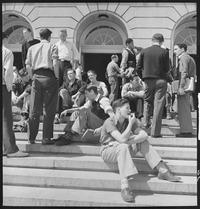
Berkeley's slow growth ended abruptly with the Great San Francisco Earthquake of 1906. The town and other parts of the East Bay somehow managed to escape serious damage from the massive temblor, and thousands of refugees flowed across the Bay.
In 1908, a statewide referendum that proposed moving the California state capital to Berkeley was defeated by a margin of about 33,000 votes. A legacy of this ballot measure that survives was the naming of streets in the vicinity of the proposed capitol grounds for the counties of California.
In 1909, the citizens of Berkeley adopted a new charter, and the Town of Berkeley became the City of Berkeley. Rapid growth continued up to the Crash of 1929. The Great Depression hit Berkeley hard, but not as hard as many other places in the U.S., thanks in part to the University.
On September 17, 1923, a major fire swept down the hills toward the University campus and the downtown section. Some 640 structures burned before a late afternoon sea breeze stopped its progress, allowing firefighters to put it out.
The next big growth occurred with the advent of World War II, when large numbers of people moved to the Bay Area to work in the many war industries, such as the immense Kaiser Shipyards in nearby Richmond. One who moved out, but played a big role in the outcome of the War was U.C. Professor and Berkeley resident J. Robert Oppenheimer. During the war, an Army base, Camp Ashby, was temporarily sited in Berkeley.
The element berkelium was synthesized and named in 1949, recognizing the University, thus also placing the city's name in the list of elements.
The postwar years saw moderate growth of the City, as events on the U.C. campus began to build up to the recognizable activism of the sixties. In 1950, the Census Bureau reported Berkeley's population as 11.7% black and 84.6% white. In the 1950s, McCarthyism induced the University to demand a loyalty oath from its professors, many of whom refused to sign the oath on the principle of freedom of thought. In 1960, a U.S. House committee (HUAC) came to San Francisco to investigate the influence of communists in the Bay Area. Their presence was met by protesters, including many from the University. Meanwhile, a number of U.C. students became active in support of the Civil Rights Movement. Finally, the University in 1964 provoked a massive student protest by banning distribution of political literature on campus. This protest became the Free Speech Movement. As the Vietnam War rapidly escalated in the ensuing years, so did student activism at the University, particularly that organized by the Vietnam Day Committee.
Berkeley is strongly identified with the rapid social changes, civic unrest, and political upheaval that characterized the late 1960s. In that period, Berkeley aeespecially Telegraph Avenue aebecame a focal point for the hippie movement, which spilled over the Bay from San Francisco. Many hippies were apolitical drop-outs, rather than students, but in the heady atmosphere of Berkeley in 1967 ae1969 there was considerable overlap of the hippie movement and the radical left. An iconic event in the Berkeley Sixties scene was a conflict over a parcel of University property south of the contiguous campus site that came to be called "People's Park."
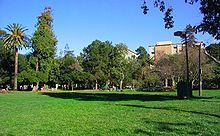
The battle over disposition of People's Park resulted in a month-long occupation of Berkeley by the National Guard on orders of then-Governor Ronald Reagan. In the end, the park remained undeveloped, and remains so today. A spin-off, "People's Park Annex," was established at the same time by activist citizens of Berkeley on a strip of land above the Bay Area Rapid Transit subway construction along Hearst Avenue northwest of the U.C. campus. The land had also been intended for development, but was turned over to the City by BART and is now Ohlone Park.
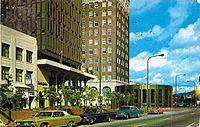
The 1970s saw a decline in the population of Berkeley, partly due to an exodus to the suburbs. Some moved because of the rising cost of living throughout the Bay Area, and others because of the decline and disappearance of many industries in West Berkeley.
From the 1980s to the present, Berkeley has seen rising housing costs, especially since the mid-1990s. In 2005 ae2007, sales of homes began to slow, but average home prices, as of 2010, remain among the highest in the nation.
The era of large public protest in Berkeley waned considerably with the end of the Vietnam War in 1974.
In 2006, the Berkeley Oak Grove Protest began protesting construction of a new sports center annex to Memorial Stadium at the expense of a grove of oak trees on the UC campus. The protest ended in September 2008 after a lengthy court process.
In 2007 ae08, Berkeley received media attention due to demonstrations against a Marine Corps recruiting office in downtown Berkeley and a series of controversial motions by Berkeley's City Council regarding opposition to Marine recruiting. (See Berkeley Marine Corps Recruiting Center controversy.)
During the fall of 2010, the Berkeley Student Food Collective opened after many protests on the UC Berkeley campus due to the proposed opening of the fast food chain Panda Express. Students and community members worked together to open a collectively-run grocery store right off of the UC Berkeley campus, where the community can buy local, seasonal, humane, and organic foods at prices that everyone can afford. The Berkeley Student Food Collective still runs to this day at 2440 Bancroft Way.
In the Fall of 2011, the nationwide Occupy Wall Street movement made its appearance at two locales in Berkeley: on the campus of the University of California and as an encampment in Civic Center Park.
On September 18, 2012, Berkeley became what is thought to be the first city in the U.S. to officially proclaim a day recognizing bisexuals September 23, which is known as Celebrate Bisexuality Day.
While the 1960s were the heyday of liberal activism in Berkeley, it remains one of the most overwhelmingly Democratic cities in the United States.
Berkeley is located at 37 °52 a²18 a³N 122 °16 a²29 a³W / 37.87167 °N 122.27472 °W / 37.87167; -122.27472 (37.871775, na122.274603).
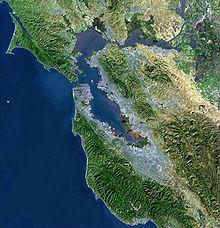
According to the United States Census Bureau the city's 17.7 square miles (46 km2) area includes 10.5 square miles (27 km2) of land and 7.2 square miles (19 km2) (40.83%) water, most of it part of San Francisco Bay.
Berkeley borders the cities of Albany, Oakland, and Emeryville and Contra Costa County including unincorporated Kensington as well as San Francisco Bay.
Berkeley lies within telephone area code 510 (until September 2, 1991, Berkeley was part of the 415 telephone code that now covers San Francisco and Marin Counties), and the postal ZIP codes are 94701 through 94710, 94712, and 94720 for the University of California campus.
Most of Berkeley lies on a rolling sedimentary plain that rises gently from sea level to the base of the Berkeley Hills. From there, the land rises dramatically. The highest peak along the ridge line above Berkeley is Grizzly Peak, elevation 1,754 feet (535 m). A number of small creeks run from the hills to the Bay through Berkeley: Cerrito, Codornices, Schoolhouse and Strawberry Creeks are the principal streams. Most of these are largely culverted once they reach the plain west of the hills.
The Berkeley Hills are part of the Pacific Coast Ranges, and run in a northwest aesoutheast alignment. In Berkeley, the hills consist mainly of a soft, crumbly rock with outcroppings of harder material of old (and extinct) volcanic origin. These rhyolite formations can be seen in several city parks and in the yards of a number of private residences. Indian Rock Park in the northeastern part of Berkeley near the Arlington/Marin Circle features a large example.
Berkeley is traversed by the Hayward Fault, a major branch of the San Andreas Fault to the west. No large earthquake has occurred on the Hayward Fault near Berkeley in historic times (except possibly in 1836), but seismologists warn about the geologic record of large temblors several times in the deeper past, and their current assessment is that a quake of 6.5 or greater is imminent, sometime within the next 30 years.
The 1868 Hayward earthquake did occur on the southern segment of the Hayward Fault in the vicinity of today's city of Hayward (hence, how the fault got its name). This quake destroyed the county seat of Alameda County then located in San Leandro and it subsequently moved to Oakland. It was strongly felt in San Francisco, causing major damage, and experienced by Samuel Clemens (Mark Twain). It was regarded as the "Great San Francisco Quake" prior to 1906. The quake produced a furrow in the ground along the fault line in Berkeley, across the grounds of the new State Asylum for the Deaf, Dumb and Blind then under construction, which was noted by one early University of California professor. Though no significant damage was reported to most of the few Berkeley buildings of the time, the 1868 quake did destroy the vulnerable adobe home of Domingo Peralta in north Berkeley.
Today, evidence of the Hayward Fault's "creeping" is visible at various locations in Berkeley. Cracked roadways, sharp jogs in streams, and springs mark the fault's path. However, since it cuts across the base of the hills, the creep is often concealed by or confused with slide activity. Some of the slide activity itself, however, results from movement on the Hayward Fault.
A notorious segment of the Hayward Fault runs lengthwise down the middle of Memorial Stadium at the mouth of Strawberry Canyon on the University of California campus. Photos and measurements show the movement of the fault through the stadium.
Berkeley has a cool summer Mediterranean climate (Koppen climate classification Csb), with dry summers and wet winters. The summers are cooler than a typical Mediterranean climate thanks to upwelling ocean currents along the California coast. These help produce cool and foggy nights and mornings. Berkeley's location directly opposite the Golden Gate ensures that typical eastward fog flow blankets the city more often than its neighbors.
Winter is punctuated with rainstorms of varying ferocity and duration, but also produces stretches of bright sunny days and clear cold nights. It does not normally snow, though occasionally the hilltops get a dusting. Spring and fall are transitional and intermediate, with some rainfall and variable temperature. Summer typically brings night and morning low clouds or fog, followed by sunny, warm days. The warmest and driest months are typically June through September, with the highest temperatures occurring in September. Mid-summer (July aeAugust) is often a bit cooler due to the sea breezes and fog common then.
Average January temperatures are a maximum of 56.4 °F (13.6 °C) and a minimum of 43.6 °F (6.4 °C). Average September (the warmest month) temperatures are a maximum of 71.7 °F (22.1 °C) and a minimum of 55.9 °F (13.3 °C). In a year, there are an average of 2.9 days with highs of 90 °F (32 °C) or higher, and an average of 0.8 days with lows of 32 °F (0 °C) or lower. The highest recorded temperature was 107 °F (42 °C) on June 15, 2000, and the lowest recorded temperature was 24 °F ( na4 °C) on December 22, 1990.
January is normally the wettest month, averaging 5.13 inches (130 mm) of precipitation. Average annual precipitation is 25.40 inches (645 mm), falling on an average of 63.7 days each year. The most rainfall in one month was 14.49 inches (368 mm) in February 1998. The most rainfall in 24 hours was 6.98 inches (177 mm) on January 4, 1982. Light snow has fallen on rare occasions. Snow has generally fallen every several years on the higher peaks of the Berkeley Hills.
In the late spring and early fall, strong offshore winds of sinking air typically develop, bringing heat and dryness to the area. In the spring, this is not usually a problem as vegetation is still moist from winter rains, but extreme dryness prevails by the fall, creating a danger of wildfires. In September 1923 a major fire swept through the neighborhoods north of the University campus, stopping just short of downtown. (See 1923 Berkeley fire). On October 20, 1991, gusty, hot winds fanned a conflagration along the Berkeley aeOakland border, killing 25 people and injuring 150, as well as destroying 2,449 single-family dwellings and 437 apartment and condominium units. (See 1991 Oakland firestorm)
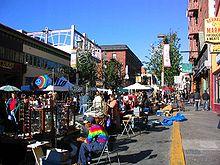
The 2010 United States Census reported that Berkeley had a population of 112,580. The population density was 10,752 people per square mile of land area (4,104/km ²). The racial makeup of Berkeley was 66,996 (59.5%) White, 11,241 (10.0%) Black or African American, 479 (0.4%) Native American, 21,690 (19.3%) Asian (8.4% Chinese, 2.4% Indian, 2.1% Korean, 1.6% Japanese, 1.5% Filipino, 1.0% Vietnamese, 0.3% Pakistani, 0.3% Thai, 0.2% Nepalese), 186 (0.2%) Pacific Islander, 4,994 (4.4%) from other races, and 6,994 (6.2%) from two or more races. Hispanic or Latino of any race were 12,209 persons (10.8%). Among the Hispanic population, 6.8% are Mexican, 0.5% Puerto Rican, 0.4% Salvadoran, 0.3% Peruvian, 0.3% Guatemalan.
The Census reported that 99,731 people (88.6% of the population) lived in households, 12,430 (11.0%) lived in non-institutionalized group quarters, and 419 (0.4%) were institutionalized.
There were 46,029 households, out of which 8,467 (18.4%) had children under the age of 18 living in them, 13,569 (29.5%) were opposite-sex married couples living together, 3,855 (8.4%) had a female householder with no husband present, 1,368 (3.0%) had a male householder with no wife present. There were 2,931 (6.4%) unmarried opposite-sex partnerships, and 961 (2.1%) same-sex married couples or partnerships. 16,904 households (36.7%) were made up of individuals and 4,578 (9.9%) had someone living alone who was 65 years of age or older. The average household size was 2.17. There were 18,792 families (40.8% of all households); the average family size was 2.81. There were 49,454 housing units at an average density of 2,794.6 per square mile (1,079.0/km ²), of which 18,846 (40.9%) were owner-occupied, and 27,183 (59.1%) were occupied by renters. The homeowner vacancy rate was 1.0%; the rental vacancy rate was 4.5%. 45,096 people (40.1% of the population) lived in owner-occupied housing units and 54,635 people (48.5%) lived in rental housing units.
The population was spread out with 13,872 people (12.3%) under the age of 18, 30,295 people (26.9%) aged 18 to 24, 30,231 people (26.9%) aged 25 to 44, 25,006 people (22.2%) aged 45 to 64, and 13,176 people (11.7%) who were 65 years of age or older. The median age was 31.0 years. For every 100 females there were 95.6 males. For every 100 females age 18 and over, there were 94.2 males.
According to a 2007 estimate, the median income for a household in the city was $57,189, and the median income for a family was $93,297. Males had a median income of $50,789 versus $40,623 for females. The per capita income for the city was $34,598. About 8.3% of families and 20.0% of the population were below the poverty line, including 13.4% of those under age 18 and 7.9% of those age 65 or over.
Berkeley is served by Amtrak (Capitol Corridor), AC Transit, BART (Downtown Berkeley Station, North Berkeley, and Ashby) and bus shuttles operated by major employers including UC Berkeley and Lawrence Berkeley National Laboratory. The Eastshore Freeway (Interstate 80 and Interstate 580) runs along the bay shoreline. Each day there is an influx of thousands of cars into the city by commuting UC faculty, staff and students, making parking for more than a few hours an expensive proposition.
Berkeley has one of the highest rates of bicycle and pedestrian commuting in the nation. Berkeley is the safest city of its size in California for pedestrians and cyclists, considering the number of injuries per pedestrian and cyclist, rather than per capita.
Berkeley has modified its original grid roadway structure through use of diverters and barriers, moving most traffic out of neighborhoods and onto arterial streets (visitors often find this confusing, because the diverters are not shown on all maps). Berkeley maintains a separate grid of arterial streets for bicycles, called Bicycle Boulevards, with bike lanes and lower amounts of car traffic than the major streets they often parallel.
Berkeley hosts car sharing networks run by City CarShare, U Car Share, and Zipcar. Rather than owning (and parking) their own cars, members share a group of cars parked nearby. Web- and telephone-based reservation systems keep track of hours and charges. Several "pods" (points of departure where cars are kept) exist throughout the city, in several downtown locations, at the Ashby and North Berkeley BART stations, and at various other locations in Berkeley (and other cities in the region). Using alternative transportation is encouraged.
Berkeley has had recurring problems with parking meter vandalism. In 1999, over 2,400 Berkeley meters were jammed, smashed, or sawed apart. Starting in 2005 and continuing into 2006, Berkeley began to phase out mechanical meters in favor of more centralized electronic meters.
The first commuter service to San Francisco was provided by the Central Pacific's Berkeley Branch Railroad, a standard gauge steam railroad, which terminated in downtown Berkeley, and connected in Emeryville (at a locale then known as "Shellmound") with trains to the Oakland ferry pier as well as with the Central Pacific main line starting in 1876. The Berkeley Branch line was extended from Shattuck and University to Vine Street ("Berryman's Station") in 1878. Starting in 1882, Berkeley trains ran directly to the Oakland Pier. In the 1880s, Southern Pacific assumed operations of the Berkeley Branch. In 1911, Southern Pacific electrified this line and the several others it constructed in Berkeley, creating its East Bay Electric Lines division. The huge and heavy cars specially built for these lines were called the "Red Trains" or the "Big Red Cars." The Shattuck line was extended and connected with two other Berkeley lines (the Ninth Street Line and the California Street line) at Solano and Colusa (the "Colusa Wye"). It was at this time that the Northbrae Tunnel and the Rose Street Undercrossing were constructed, both of which still exist (the Rose Street Undercrossing is not accessible to the public, being situated between what is now two backyards). The fourth Berkeley line was the Ellsworth St. line to the university campus. The last Red Trains ran in July, 1941.
The first electric rail service in Berkeley was provided by several small streetcar companies starting in 1891. Most of these were eventually bought up by the Key System of Francis "Borax" Smith who added lines and improved equipment. The Key System's streetcars were operated by its East Bay Street Railways division. Principal lines in Berkeley ran on Euclid, The Arlington, College, Telegraph, Shattuck, San Pablo, University, and Grove (today's Martin Luther King Jr. Way). The last streetcars ran in 1948, replaced by buses.
The first electric commuter interurban-type trains to San Francisco from Berkeley were put in operation by the Key System in 1903, several years before the Southern Pacific electrified its steam commuter lines. Like the SP, Key trains ran to a pier serviced by the Key's own fleet of ferryboats, which also docked at the Ferry Building in San Francisco. After the Bay Bridge was built, the Key trains ran to the Transbay Terminal in San Francisco, sharing tracks on the lower deck of the Bay Bridge with the SP's red trains and the Sacramento Northern Railroad. It was at this time that the Key trains acquired their letter designations, which were later preserved by Key's public successor, AC Transit. Today's F bus is the successor of the F train. Likewise, the E, G and the H. Before the Bridge, these lines were simply the Shattuck Avenue Line, the Claremont Line, the Westbrae Line, and the Sacramento Street Line, respectively.
After the Southern Pacific abandoned transbay service in 1941, the Key System acquired the rights to use its tracks and catenary on Shattuck north of Dwight Way and through the Northbrae Tunnel to The Alameda for the F-train. The SP tracks along Monterey Avenue as far as Colusa had been acquired by the Key System in 1933 for the H-train, but were abandoned in 1941. The Key System trains stopped running in April 1958. In 1963, the Northbrae Tunnel was opened to auto traffic.
According to the City's 2009 Comprehensive Annual Financial Report, the top employers in the city are:
Berkeley is the location of a number of nationally prominent businesses, many of which have been pioneers in their areas of operation.

Berkeley has a number of distinct neighborhoods.
Surrounding the University of California campus are the most densely populated parts of the city. West of the campus is Downtown Berkeley, the city's traditional commercial core; home of the civic center, the city's only public high school, the busiest BART station in Berkeley, as well as a major transfer point for AC Transit buses. South of the campus is the Southside neighborhood, mainly a student ghetto, where much of the university's student housing is located. The busiest stretch of Telegraph Avenue is in this neighborhood. North of the campus is the quieter Northside neighborhood, the location of the Graduate Theological Union.
Further from the university campus, the influence of the University quickly becomes less visible. Most of Berkeley's neighborhoods are primarily made up of detached houses, often with separate in-law units in the rear, although larger apartment buildings are also common in many neighborhoods. Commercial activities are concentrated along the major avenues and at important intersections.
In the southeastern corner of the city is the Claremont District, home to the Claremont Hotel; and the Elmwood District, with a small shopping area on College Avenue. West of Elmwood is South Berkeley, known for its weekend flea market at the Ashby Station.
West of (and including) San Pablo Avenue, a major commercial corridor, is West Berkeley, the historic commercial center of the city, and the former unincorporated town of Ocean View. West Berkeley contains the remnants of Berkeley's industrial area, much of which has been replaced by retail and office uses, as well as residential live/work loft space, with the decline of manufacturing in the United States. The areas of South and West Berkeley are in the midst of redevelopment. Some residents have opposed redevelopment in this area. Along the shoreline of San Francisco Bay at the foot of University Avenue is the Berkeley Marina. Nearby is Berkeley's Aquatic Park, featuring an artificial linear lagoon of San Francisco Bay.
North of Downtown is the North Berkeley neighborhood, which has been nicknamed the "Gourmet Ghetto" because of the concentration of well-known restaurants and other food-related businesses. Further north are Northbrae, a master-planned subdivision from the early 20th century, and Thousand Oaks. Above these last three neighborhoods, in the northeastern part of Berkeley, are the Berkeley Hills. The neighborhoods of the Berkeley Hills such as Cragmont and La Loma Park are notable for their dramatic views, winding streets, and numerous public stairways and paths.
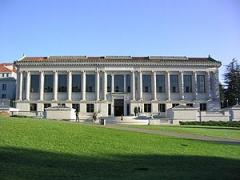
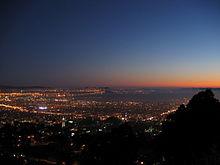
The city has many parks puts a focus on greenery and the environment. The city has planted trees for years and led the effort nationwide to re-tree urban areas. The city's hills are covered by Tilden Regional Park much of which is in Richmond. The city is also heavily involved in creek restoration and wetlands restoration, including a planned daylighting of Strawberry Creek along Center Street. The Berkeley Marina and East Shore State Park flank its shoreline at San Francisco Bay and organizations like the Urban Creeks Council and Friends of the Five Creeks the former of which is headquartered in Berkeley support the riparian areas in the town and coastlines as well. Cesar ChR¡vez Park, near the Berkeley Marina, was built at the former site of the city dump.
165 buildings in Berkeley are designated as local landmarks or local structures of merit. Of these, 49 are listed in the National Register of Historic Places, including:
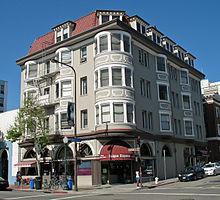
Historic Districts listed in the National Register of Historic Places:
See List of Berkeley Landmarks, Structures of Merit, and Historic Districts
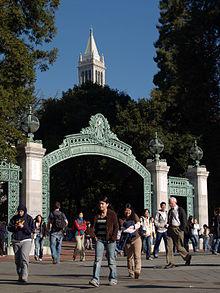
Berkeley is home to the Chilean-American community's La PeR±a Cultural Center, the largest cultural center for this community in the United States.
University of California Berkeley's main campus is in the city limits.
The Graduate Theological Union, a consortium of nine independent theological schools, is located a block north of the University of California Berkeley's main campus. The Graduate Theological Union has the largest number of students and faculty of any religious studies doctoral program in the United States. In addition, Berkeley City College is a community college in the Peralta Community College District.
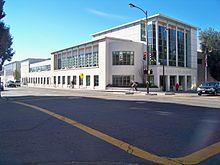
The Berkeley Unified School District operates public schools.
The first public school in Berkeley was the Ocean View School, now the site of the Berkeley Adult School located at Virginia Street and San Pablo Avenue. The public schools today are administered by the Berkeley Unified School District. In the 1960s, Berkeley was one of the earliest US cities to voluntarily desegregate, utilizing a system of buses, still in use. The city has one public high school, Berkeley High School (BHS). Established in 1880, BHS currently has over 3,000 students. The Berkeley High campus was designated a historic district by the National Register of Historic Places on January 7, 2008. Saint Mary's College High School, a Catholic school, has its street address in Berkeley, although most of the grounds and buildings are actually in neighboring Albany. Berkeley has 11 elementary schools and three middle schools.
There is also the Bay Area Technology School, the only school in the whole Bay Area to offer a technology- and science-based curriculum, with connections to leading universities.
Berkeley Public Library serves as the municipal library. University of California, Berkeley Libraries operates the University of California Berkeley libraries.
City of Berkeley Mayor's Office
Berkeley has 14 sister cities:

Word Count: 6319







